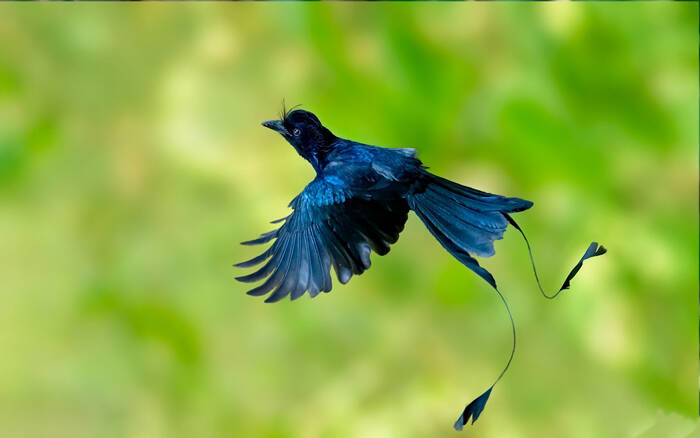Dicrurus paradiseus
IUCN
LCBasic Information
Scientific classification
- name:Dicrurus paradiseus
- Scientific Name:Dicrurus paradiseus,Greater Racket-tailed Drongo,Large drongo, long-tailed drongo, arrow-bearing bird
- Outline:Songbird
- Family:Passeriformes Drongo
Vital signs
- length:45-60cm
- Weight:73-100g
- lifetime:No verification information
Feature
Similar in appearance to the small disc tail, but larger in size
Distribution and Habitat
Distributed in Bangladesh, Bhutan, Brunei, Cambodia, China, India, Indonesia, Lao People's Democratic Republic, Malaysia, Myanmar, Nepal, Singapore, Sri Lanka, Thailand, Vietnam.
In China, it is distributed in Yingjiang in western Yunnan, Xishuangbanna and Luchun in the south, and the western, central and southern mountains of Hainan Island. The distribution area of the big pan-tail in this country is narrow and the population is sparse.
It mainly inhabits evergreen broad-leaved forests and secondary forests in tropical broad-leaved rain forests, original dense forests, low mountains and hills, and foothill plains. It is also found in open areas between forests or near forest grasslands. It also often appears in bamboo forests, farmlands, and small jungles near villages, orchards, and sparse forests and grass slopes.
Appearance
Large plate-tailed male adult bird: completely black with a metallic purple-blue sheen; the clustered feather crest on the forehead is well-developed, standing on the front of the head, covering the nostrils forward, some extending to the front of the mouth, and extending backward to the pillow The crown feathers are pure black with shiny edges; the top feathers on the top of the head are scaly and shiny; the eye, cheek and ear feathers are pure black; the feathers on the sides and back of the head and neck are lanceolate and purple-blue shiny; the upper part is The back and shoulders of the body have a pronounced metallic luster, and the waist and upper tail coverts are only slightly shiny; the tail feathers are forked and have a metallic luster, and the rachis of the outermost pair of tail feathers are evenly extended, with the stems of the rachis partially exposed and the inner leaflets degenerated. Or narrow, the outer feathers are broad and developed, so the outer feathers at the
Details
Greater Racket-tailed Drongo has 13 subspecies.

Greater Racket-tailed Drongo is mainly a resident bird, and some are summer migrants, wandering elsewhere in winter. The Great Discus often rests on a solitary tree in an open space. Occasionally, it suddenly takes off, quickly chases the flying insects, and then returns to the original branch where it rests. Sometimes, it also flies in the open forest grassland, making waves or gliding, with a pair of "disk-shaped tails" floating on the back of its body, chasing the frightened flying insects in the grass on the ground. It often moves alone or in pairs, and sometimes in small groups of 3-5 in places with abundant food. When flying, it drags a long tail, flying in waves, with a graceful posture and a crisp and pleasant call.
The Great Discus mainly feeds on insects such as locusts and grasshoppers, and also eats small vertebrates such as lizards and frogs. It usually stands high in the trees to peek at the surrounding movements, and immediately flies to catch the prey when it finds it, and then flies back to the original place to swallow it.
The breeding season of the Great Ducktail is from April to June. The nest is built in evergreen broad-leaved forests below 1,000 meters above sea level. The nest is mostly placed on the end of some small branches at the top of broad-leaved trees, swaying in the wind like a child's cradle. The nest is mainly made of twigs, reed stems, roots and dead grass, firmly fixed on the branches. There are spider webs on the outer wall of the nest, and sometimes it is decorated with some mosses, lichens and bark, etc., more than 5 meters above the ground. Each nest lays 3-4 eggs. The eggs are of two types: long oval and pointed oval, mostly white, occasionally milky white, with two layers of light and dark red, brown or purple spots, especially denser at the blunt end. The size of the egg is 26-32.4 mm × 20-22.5 mm. The male and female take turns incubating the eggs, and the chicks mature late.
According to MacKinnon and Phillips' 1993 survey, the species is becoming increasingly rare due to the reduction in lowland forest area in Java and Bali, Indonesia. It is suspected that the loss of this habitat is continuing.
The distribution range of the Greater Ducktail is wide, and it is not close to the critical value of vulnerable endangered species survival (distribution area or fluctuation range less than 20,000 square kilometers, habitat quality, population size, and distribution area fragmentation). The population trend is stable, so it is evaluated as a species with no survival crisis.
Listed in the "Red List of Endangered Species of the World Conservation Union" (IUCN) 2016 ver 3.1-Least Concern (LC).
The subspecies distributed in China is included in the "List of Terrestrial Wildlife with Important Economic and Scientific Research Value under State Protection" (Item 398) issued by the State Forestry Administration of China on August 1, 2000.
Listed in the second level of China's "List of National Key Protected Wildlife" (February 5, 2021).
Protect wild animals and eliminate game.
Maintaining ecological balance is everyone's responsibility!








